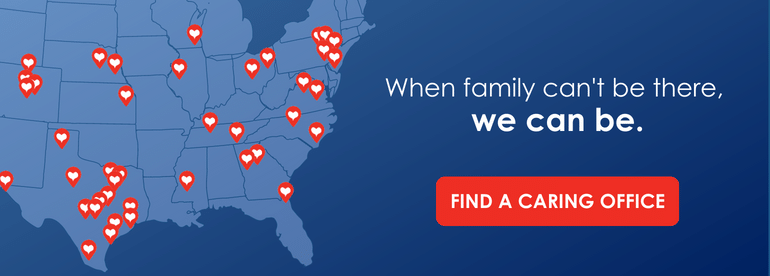The National Association for Continence estimates that more than 25 million people in the United States experience incontinence. Despite how common incontinence is, it can cause a very stressful situation for older adults with the condition. From their perspective, urination and elimination are very sensitive personal functions. And from a caregiving perspective, you may find it offers a particular challenge: how do you gracefully and respectfully deal with with incontinence in senior clients?
Though each situation is unique, there are a few important considerations to keep in mind. Most importantly, the fact that incontinence is common doesn't mean it should be accepted as inevitable for a client. There are plenty of ways to manage incontinence through medical interventions and lifestyle changes. As a caregiver, you can help deal with incontinence gracefully by following some of these guidelines.
1. Maintain Open Communication
Because continence is such a personal and physical concern, you might feel reluctant to bring up the conversation in the first place. However, it's always more effective in the long run to establish clear communication with your client. This way, you will both feel more comfortable with the issue, and you'll also be better prepared handle any new, related issues that may come up.
If the senior you are caring for has Alzheimer's or dementia along with incontinence, you may have to approach your conversation even more carefully. Because your senior might be grappling with extra confusion, The Alzheimer's Association recommends a clear approach with communication. Here are some ideas:
- Get acquainted with the nonverbal communication some people might exhibit when they need to use the restroom. For example, you might notice that your client is especially restless before needing to use the toilet.
- Avoid using childlike terms like "potty" when it comes to communication. Use normal adult language like "toilet" and "restroom" to keep the communication respectful.
- Keep up open lines of communication so that your client feels empowered to alert you of the need to use the restroom — especially if they need assistance with mobility.
- Let your client know that you are available to listen, and that you truly want to help them handle their incontinence with dignity and grace.
2. Get Educated
Staying educated about incontinence will give you more insight into what your client is going through. In addition, understanding the different types and causes of incontinence can be a valuable asset when it comes to seeking or advocating for medical assistance. For instance, you should know that there are several different types of urinary incontinence, and be able to identify which one is relevant to the situation.
Here is a brief overview of the different types of incontinence.
- Stress incontinence: With stress incontinence, an individual might accidentally urinate when they laugh, cough, or jump — anything that adds pressure on the bladder. This type of incontinence is anatomical, usually caused by weakness or damage to the pelvic floor muscles or urethral sphincter. Often, this is associated with women who've gone through childbirth and can also be age-related.
- Urge incontinence: Also known as overactive bladder, urge incontinence happens when you have an "urge" to go to the bathroom even when your bladder isn't full. Often, this is caused by the bladder muscle contracting when the bladder isn't full. This can be caused by diabetes, urinary tract infections, Parkinson's Disease, or neurological disease or injury.
- Overflow incontinence: More common in men than women, overflow incontinence is often caused by something obstructing urine flow. When flow is blocked, it can lead to the bladder never fully emptying. This is often caused by prostate enlargement but can also be medication-related.
- Functional incontinence: In cases of functional incontinence, there are other factors beside the urinary tract which are causing issues. For example, having mobility restrictions, being diagnosed with dementia, or taking diuretic medications can make it difficult for people to reach the restroom in time to avoid an accident.
- Reflex incontinence: Often associated with nerve damage from spinal cord injury, multiple sclerosis, or surgical damage, this type of incontinence means that the bladder will reflexively contract even when someone doesn't have the urge to go.
Staying educated about the different types of incontinence can not only help you support your client better but can help you remain educated about any other underlying medical conditions.
3. Empower Your Client to Seek Help
Knowing that incontinence is often caused or aggravated by underlying health conditions, you can help your client seek medical help to treat or decrease their incontinence. According to the National Institute on Aging (NIH), incontinence can generally be "cured or controlled" with the right interventions. To help your client handle this sometimes difficult issue gracefully, make sure to help them seek the help they need. Depending on their situation, this could include:
- Visiting a urologist to get to the root of the issue
- Seeing a physical therapist who specializes in pelvic floor dysfunction
- Getting treatment for urinary tract infections
- Exploring biofeedback options to regain control over muscles
- Embracing lifestyle changes like drinking less alcohol or coffee
- Talking to a doctor about medications that might be contributing to incontinence
4. Remain Prepared
Gracefully dealing with incontinence in a senior means always remaining prepared. Part of this involves clear communication with your client, the right education and insight into the issue, and seeking the appropriate medical help. But as a caregiver, it's also really important to manage the day-to-day, practical concerns of incontinence. This will look different depending on the situation.
Here are some tips to remain prepared for anything.
- On outings, always keep tabs on where restrooms are to avoid a stressful situation.
- Ensure that bathrooms inside the home or facility are easy to get to and accommodating for your client.
- If necessary, prepare for nighttime incontinence ahead of time through the use of waterproof mattress protection.
- When traveling, stay prepared by bringing a pack full of necessities: pads or briefs, wipes for cleaning, and a change of clothes.
- Help your client stay prepared by recognizing triggers and patterns. For example, do they tend to need to urinate every hour? Every 2 hours? Is it aggravated by things like caffeine?
- Becoming dehydrated can actually cause bladder irritation and make the issue worse, so plan ahead by helping your client stay fully hydrated at all times.
5. Practice Compassion & Humor
As a caregiver, you know the importance of compassion when caring for your clients. Studies and research have consistently backed up the power of truly connecting and listening to clients. In fact, people who experience empathy and listening from their caregivers have better clinical outcomes, feel more comfortable discussing their symptoms, and even recover quicker from the common cold!
During all your interactions with the senior you're caring for, practice empathetic listening. Be patient and understanding, keeping in mind that the people you are caring for have lived full, independent lives — and may be reliant on care for the first time. Don't be afraid to ask questions and keep a sense of humor — as long as you are caring, compassionate, and thoughtful in every interaction.
Handling Incontinence with Grace
Incontinence doesn't have to negatively impact a person's quality of life, or cause them to feel any undue embarrassment or stress. In most cases, it's an issue that can be dealt with alongside a great team of medical professionals and caregivers.
With a little bit of preparation, education, communication, and compassion, you're well on your way to handling your client's incontinence with grace and dignity. For more information about providing excellent care, please don't hesitate to reach out to your local Caring office today.


